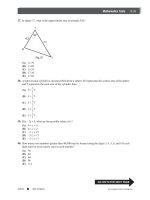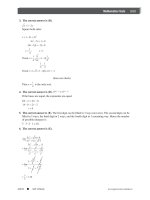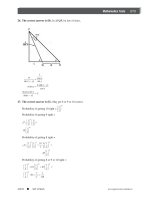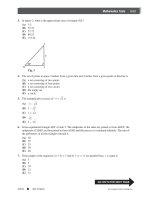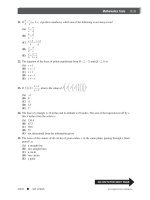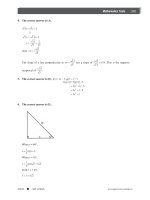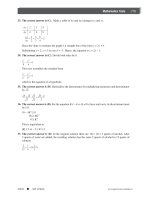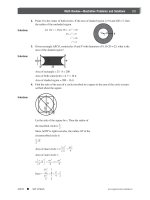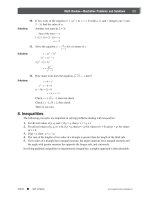SAT II History Episode 2 Part 3 pdf
Bạn đang xem bản rút gọn của tài liệu. Xem và tải ngay bản đầy đủ của tài liệu tại đây (122.62 KB, 20 trang )
down in Congress. After Kennedy’s assassination, Johnson, using
the powers of persuasion and negotiating skills he had developed
as Senate majority leader, was able to win passage of a tax cut
bill that promised $11 billion in personal and corporate tax relief to
boost spending.
Test-Taking Strategy
Truman had advocated a
similar Medicare program,
but conservatives in Con-
gress had rejected it. Track
how conservative interests
have affected American
policy in the twentieth
century.
• Johnson’s own domestic program was called the Great Society.
Major legislation included (1) the Economic Opportunity Act that
launched the “war on poverty,” (2) Medicare, (3) Medicaid, and
(4) the Elementary and Secondary Education Act of 1965.
• In time, the escalating Vietnam War drained Johnson’s energy and
strained the national budget. The trade-off symbolized by the
phrase “guns or butter” became a reality. To push a tax cut
through Congress to ease the growing federal deficit, Johnson
slashed the funding for social programs and effectively, the “war
on poverty.”
Civil Rights
• One of the most far-reaching of Johnson’s acts was his issuance of
an Executive Order in 1964 that all contractors working on federal
projects “take af firmative action” to ensure that they did not
discriminate in hiring or promoting members of minority groups.
This Order was meant to enforce the provisions of the Civil Rights
Act of 1964 for federal projects. The concept became institutional-
ized when President Nixon set specific goals, or quotas, for
federally financed construction projects.
• During these years, a number of significant pieces of legislation
were passed and Supreme Court decisions handed down that
expanded civil rights.
CIVIL RIGHTS LEGISLATION
LEGISLATION/RULING SIGNIFICANCE
Civil Rights Act, 1964 • Prohibits discrimination in public accommodations
• Authorizes the U.S. attorney general to intervene on behalf of
victims of discrimination
• Forbids employers and unions to discriminate against minorities
• Enables the federal government to withhold funding from
projects in which discrimination exists
• Forbids the use of different standards for whites and African
Americans applying to register to vote
Twenty-Fourth Amendment Outlaws the use of a poll tax or any tax to keep African Americans
from voting in federal elections
REVIEWING THE KENNEDY TO THE BUSH ADMINISTRATIONS
215
Peterson’s n SAT II
Success: U.S. History www.petersons.com
CIVIL RIGHTS LEGISLATION
LEGISLATION/RULING SIGNIFICANCE
Voting Rights Act, 1965 Allows the federal government to register voters in localities where
literacy tests and similar restrictions were in effect as of November
1, 1964, and where less than half the eligible voters had registered
and voted in the 1964 federal election (most of the South)
Heart of Atlanta v. United
States
Upholds the use of the commerce clause as the basis for civil rights
legislation
Wesbery v. Sanders Ends pattern of overrepresentation of rural districts and
underrepresentation of cities in legislatures; “one man, one vote”
Heart of Atlanta Motel v. United States (1964; interstate commerce)
Case: In 1964, Congress, using its power to regulate interstate commerce under Article I, Section
8, passed the Civil Rights Act banning discrimination in public accommodations and in
employment. A motel owner challenged the law on the basis that his business was local—even
though it was convenient to exits for an interstate—and, therefore, should not be regulated
under interstate commerce.
Decision: The Warren Court ruled against the owner. It based its decision on the theory that
public accommodations, places that sell lodging (hotels, rooming houses, etc.), food (restaurants,
lunch counters, etc.), and entertainment (movie theaters, auditoriums, etc.) serve transients
and/or have moved a large portion of their goods by interstate commerce. In its opinion, the
Court found “overwhelming evidence of the disruptive effect [of] racial discrimination” on
commerce.
Significance: The Court’s ruling upheld Congress’s use of the commerce clause as the basis for
civil rights legislation.
CHAPTER 8
216
Peterson’s n SAT II
Success: U.S. Historywww.petersons.com
Wesbery v. Sanders (1964; one man, one vote)
Case: As a result of the 1960 Census, Georgia’s ten Congressional districts were reapportioned.
The Fifth District had more than 800,000 people, while the other nine districts had just under
400,000 on average. Several members of the Fifth Congressional District joined in a suit against
Sanders, their representative, claiming that the size of the district deprived them of equal
representation.
Decision: The Court, citing Article I, Section 2, ruled that the difference in size of the
population of the ten Congressional districts violated the Constitution.
Significance: This case was one in a series of cases dealing with apportionment of state and
Congressional seats that the Court agreed to hear. The decisions in these cases, known
collectively as “one man, one vote,” ended the pattern of rural overrepresentation and urban
underrepresentation in legislatures.
• The most prominent civil rights activist of the late 1950s and 1960s
was the Reverend Martin Luther King Jr. Head of the Southern
Christian Leadership Conference (SCLC), he preached nonvio-
lence and led a series of demonstrations and marches to protest
racial discrimination—until his assassination in 1968. Similar in
approach was the Congress of Racial Equality (CORE) which
was founded by James Far mer.
• The Student Nonviolent Coordinating Committee (SNCC)
began with similar objectives and tactics but changed under the
leadership of Stokely Car michael, who championed Black
Power. This caused a split between SNCC and more mainline
organizations like the SCLC and the NAACP. Carmichael defined
Black Power as a call to African Americans “to unite, to recognize
their heritage, to build a sense of community.”
• The following were major civil rights’ activities of the 1950s
and 1960s:
CIVIL RIGHTS MOVEMENT
ACTIVITY SIGNIFICANCE
Montgomery bus boycott,
1955
• Protested segregation in public buses; lasted more than a year;
Supreme Court found bus segregation unconstitutional
• Launched Martin Luther King Jr., as most prominent member of
the Civil Rights Movement
Desegregation of Little Rock
High School, Arkansas, 1957
• Governor Orval Faubus blocked enforcement of Brown v. Board
of Education by calling out the Arkansas National Guard to stop
students.
• Eisenhower took over National Guard and ordered admission of
black students.
REVIEWING THE KENNEDY TO THE BUSH ADMINISTRATIONS
217
Peterson’s n SAT II
Success: U.S. History www.petersons.com
CIVIL RIGHTS MOVEMENT
ACTIVITY SIGNIFICANCE
Greensboro, North
Carolina, Sit-in, 1960
• A group of integrated college students take over a lunch counter
at Woolworth’s and request service, which is denied.
• Sit-ins spread across the South to protest segregation in public
accommodations.
Freedom rides, 1961 • Groups of students rode interstate carriers to protest segregation
on interstate buses and in bus terminals.
• President Kennedy ordered federal marshals to accompany riders
into the Deep South.
• Federal government issued tougher regulations against
segregation on interstate transit.
March on Washington, 1963 Some 250,000 Americans—black and white—marched in
Washington to protest segregation. Pressed Congress to pass the
civil rights bill that President Kennedy sent to Congress.
Freedom Summer, 1964 • Four civil rights organizations joined to lead a voter registration
drive in the South.
• Three volunteers were murdered, and seven Ku Klux Klan
members were tried and convicted.
• The 1960s also saw the emergence of a civil rights movement
among Mexican Americans or chicanos/chicanas. Led by César
Chávez and Dolores Huerta, Mexican farm workers formed the
National Far m Workers Association (NFWA) and organized a
nationwide boycott of table grapes.
• The women’s movement emerged in the mid-1960s, seeking
equal pay for equal opportunity. A major force was the publication
of The Feminine Mystique by Betty Friedan. The National
Organization for Women (NOW), founded in 1966, worked for
passage of the Equal Rights Amendment (ERA), but the amend-
ment was never ratified by the required number of states. Some
opponents feared that it would cause women to lose some of the
protection they already had under existing laws. Conservatives
equated the law with everything from federal funding for abortion
to unisex toilets.
• The Supreme Court also handed down a number of rulings that
expanded civil liberties.
CHAPTER 8
218
Peterson’s n SAT II
Success: U.S. Historywww.petersons.com
Gideon v. Wainwright (1963; right to be represented by counsel)
Case: Clarence Earl Gideon was charged with robbing a Florida pool hall—a felony. Penniless,
Gideon asked for a court-appointed lawyer and was denied. Convicted and sentenced to five
years in jail, Gideon crafted his own appeal and sent it to the Supreme Court.
Decision: The Court overturned the conviction, stating that the due process clause of the
Fourteenth Amendment protects individuals against state encroachments on their rights.
Represented by counsel, Gideon was retried and acquitted.
Significance: Florida, as well as other states, had to release prisoners who had not been
represented by an attorney. As a result of Gideon, everyone accused of a crime must be
represented by an attorney. If a person is too poor, then the state must provide one. This is one
of several cases dealing with the rights of the accused that the Warren Court agreed to hear.
Many of the decisions have been controversial among conservatives, because they think the
Warren Court was soft on criminals.
Miranda v. Arizona (1966; Miranda Rule)
Case: Ernesto Miranda was arrested on charges of kidnapping and rape and was identified by the
victim. He was not informed of his right to have an attorney present during questioning. After 2
hours of interrogation, Miranda confessed and voluntarily signed a confession, which was later
used in court. Miranda was convicted and appealed. His lawyer argued that Miranda’s right under
the Fifth Amendment to avoid self-incrimination was violated when he was not informed of his
right to have a lawyer present.
Decision: The Warren Court reversed the conviction in a 5–4 decision. It ruled that a suspect
must be “read his rights:” the right to remain silent, that anything that the suspect says may be
used against him/her in a court of law, the right to have an attorney present during questioning,
the right to have a court-appointed attorney if the person cannot afford one, and the right to end
questioning at any time.
Significance: The Warren Court stated that the Court would not uphold any convictions on
appeal if the suspects had not been informed of their constitutional rights before questioning.
Conservatives criticized the ruling for tying the hands of the police, although many law
enforcement officials said that by setting rules, it made everyone aware of what was expected
and how the police needed to do their jobs.
Cuba
• Shortly after taking office, Kennedy was confronted with the
dilemma regarding continued support for an invasion of Cuba by
1,500 anti-Castro Cubans. The Central Intelligence Agency
(CIA), with Eisenhower’s approval, had begun the project.
Kennedy decided to provide weapons and ships to transport the
exiles but to provide no military support. The CIA and the Cuban
exiles expected Cubans to take up arms and oust Castro, but the
REVIEWING THE KENNEDY TO THE BUSH ADMINISTRATIONS
219
Peterson’s n SAT II
Success: U.S. History www.petersons.com
insurrection never materialized. All the exiles were killed or
captured. The United States took a great deal of criticism from
around the world, especially from Latin American nations, for what
became known as the Bay of Pigs invasion.
• Kennedy dealt more successfully with the Cuban Missile Crisis.
The Soviet Union, an ally of Castro, had secretly constructed
missile sites in Cuba, some 90 miles from the U.S. mainland.
Kennedy ordered the U.S. Navy to throw up a blockade around
the island and turn back Soviet ships steaming toward Cuba with
nuclear missiles to arm the sites. After a week, Nikita Khrush-
chev, the Soviet premier, ordered the ships to return to the USSR
without delivering the missiles.
The Escalating Vietnam Conflict
Review Strategy
See p. 222, for the end of the
Vietnam War.
• After World War II, France reluctantly gave up its claim to Viet-
nam, and the nation was divided into North and South Vietnam,
with Communists in power in the North. Ngo Dinh Diem refused
to hold free elections in the South in 1956 for fear that the
Communists would win. When his regime did not topple but
seemed instead to be gaining strength, the Communist Viet Cong
began a guerrilla campaign to take the South.
• Eisenhower and then Kennedy, believing in the domino theory,
sent military advisers to help the government of South Vietnam.
Under Kennedy, the United States engineered the ouster of the
Diem family and the installation of a civilian as the head of the
government. Power would change several more times before the
war was over. While the well-organized and highly disciplined Viet
Cong were finding support in the countryside, the government in
Saigon seemed unable to achieve stability.
• Johnson manufactured the crisis that allowed him to ask Congress
to approve the Gulf of Tonkin Resolution. (The War Powers
Resolution that was passed in 1973 was in direct response to the
use of presidential powers in the Vietnam War.) Also believing in
the domino theory, Johnson ordered an escalation of the war by
bombing North Vietnam and sending more U.S. ground troops.
Underestimating the resolve of Ho Chi Minh and the Communists,
Johnson expected this show of force and determination on the part
of the United States to force the Viet Cong to sue for peace within
the year. However, the Communists had their own theory that they
could outwait the Americans, who would tire of the war and the
antiwar demonstrations at home.
• In January 1968, to coincide with the Vietnamese New Year (Tet),
the North Vietnamese and Viet Cong staged the Tet offensive.
This was a group of attacks on cities and U.S. bases in South
Vietnam and even the U.S. embassy in Saigon.
• The number of U.S. troops in Vietnam continued to grow and, with
it, antiwar protests in the United States. These mirrored the
CHAPTER 8
220
Peterson’s n SAT II
Success: U.S. Historywww.petersons.com
dissension and confusion in Congress with hawks against doves.
Ultimately, the escalating war in Vietnam cost Johnson both his
Great Society programs and his presidency. Faced with challenges
by antiwar Senators Eugene McCarthy and Robert F. Kennedy,
Johnson (1) ended bombing raids over most of North Vietnam, (2)
refused to send any more troops, and (3) withdrew from the 1968
presidential election.
KEY PEOPLE
Review Strategy
See if you can relate these
people to their correct
context in the “Fast Facts”
section.
• Black Panthers
• Rachel Carson, Silent Spring
• Malcolm X, Black Nationalism, Nation of Islam
• Michael Harrington, The Other America
• Ralph Nader, Unsafe at Any Speed
• Rosa Parks, Montgomery, NAACP
• “silent majority”
KEY TERMS/IDEAS
Review Strategy
See if you can relate these
terms and ideas to their
correct context in the “Fast
Facts” section.
• Alliance for Progress, stop the spread of communism, Latin
America
• American Indian Movement (AIM)
• Berlin Crisis, Berlin Wall
• Brown Power
• Communications Satellite Act, Telstar communications
satellite system, private corporation
• counterculture, youth culture, antimaterialistic, utopian
communes, “Never trust anyone over 30”
• Food for Peace
• “Letter from a Birmingham Jail,” Dr. Martin Luther King Jr.
• NASA; Mercury, Gemini, Apollo space programs
• Peace Corps
• reverse discrimination, white backlash
• VISTA (Volunteers in Service to America)
• Watts riots
SECTION 2. THE NIXON YEARS
After his defeat in the 1960 presidential election by John F.
Kennedy, Richard Nixon returned to California. When he lost his
1962 bid for the California governorship, he vowed to leave politics
forever. However, within two years, Nixon was back on the political
scene. He methodically restored his old party ties and won the
Republican nomination for president in 1968. The Democrats
REVIEWING THE KENNEDY TO THE BUSH ADMINISTRATIONS
221
Peterson’s n SAT II
Success: U.S. History www.petersons.com
nominated Hubert Humphrey. The presence of third-party candi-
date George Wallace made the outcome uncertain, but Nixon won
in a very close race. Had Wallace won a few more electoral votes, the
election could have been thrown into the House. Then Nixon might
have had to negotiate with Wallace for his votes, thus making him
beholden to Wallace.
FAST FACTS
Foreign Policy
• With Henry Kissinger as his National Security Adviser, Nixon
set about leaving his mark on world affairs. Impatient with the time
involved and the maneuverings inherent in the regular diplomatic
channels, Nixon and Kissinger carried on their own high-level
negotiations without including the secretary of state or normal
government channels. The two men believed that the U.S.’s
reputation in world affairs had suffered as the Soviet Union had
become more powerful. Rather than continue a foreign policy
based on moral principles, the United States needed to consider the
realities of power and develop policies on a pragmatic basis.
• Nixon, with Kissinger’s aid, embarked on finding a solution to the
Vietnam War. He announced his Vietnamization policy while
carrying on a series of negotiating sessions with the North Vietnam-
ese. The talks continued throughout 1970 and 1971, while U.S.
troops were withdrawn from Vietnam. On February 27, 1973, after
massive bombing of the North, North and South Vietnam and the
United States signed a cease-fire agreement. A month later, the
last of the U.S. troops was gone. The South Vietnamese hung on
for another year, but, in 1975, the government collapsed, and the
North Vietnamese proclaimed a single unified nation. Cambodia
and Laos also fell to Communist-backed governments.
• Once a strong supporter of Nationalist China (Taiwan), Nixon
made an overture to the People’s Republic of China to establish
friendly relations. The United States had severed all diplomatic and
trading ties with mainland China when the PRC was established in
1949. Nixon visited the mainland, and both nations agreed to a
policy of peaceful coexistence. Additional outcomes were (1)
resumption of trade between the two nations, (2) agreement by the
United States that Taiwan was part of China, (3) withdrawal of U.S.
troops from Taiwan, but (4) continuation of U.S. diplomatic and
trade relations with Taiwan.
Test-Taking Strategy
Track the various programs
and policies that the United
States adopted to counteract
the rise of the Soviet Union
after World War II.
• Pursuing a policy known as détente, Nixon eased tensions with
the Soviet Union. As early as 1969, the two nations had signed a
nuclear nonproliferation treaty. The Soviet Union was inter-
ested in relaxing tensions with the United States to strengthen its
own position against the PRC and to buy U.S. wheat to ease its
food shortages caused by poor harvests. Nixon visited Russia, and
CHAPTER 8
222
Peterson’s n SAT II
Success: U.S. Historywww.petersons.com
(1) signed the first round of the Strategic Arms Limitation
treaties (SALT I), limiting the spread of antiballistic missiles, and
(2) agreed to cooperate in health research, space exploration,
trade, and pollution control.
Domestic Policy
• In domestic policies, Nixon launched the New Federalism, aimed
at reducing big government and returning more power to state and
local governments. His major tool was revenue sharing, which
returned to states and municipalities some of the revenue from
income taxes. This was in place of the federal government’s paying
directly for programs. A significant provision of revenue sharing
was that programs that received the funds could not engage in
racial or ethnic discrimination. (Opposition from Reagan and the
worsening federal budget deficit killed revenue sharing in 1987.
The Supreme Court
Review Strategy
For more on interpretations
of the Constitution, see
Chapter 2.
• Nixon had the opportunity to change the nature of the Supreme
Court while president. When Chief Justice Earl Warren retired in
1969, Nixon nominated strict constructionist Warren E. Burger
to replace him. Nixon’s next two nominees were rejected as unfit,
but, ultimately, Nixon replaced three additional justices, thus
turning the court from judicial activism to a more conservative
reading of the law.
• However, the Supreme Court during Nixon’s administrations still
handed down decisions that were controversial. One of the most
controversial and vigorously opposed by conservatives and others
was Roe v. Wade.
REVIEWING THE KENNEDY TO THE BUSH ADMINISTRATIONS
223
Peterson’s n SAT II
Success: U.S. History www.petersons.com
Roe v. Wade (1973; right to privacy)
Case: Looking for a case to test state laws against abortion, advocates found it in Roe v. Wade.A
Texas law banned all abortions except those to save the life of the mother. An unwed pregnant
woman sought an abortion and was denied. Her case was appealed to the Supreme Court.
Decision: In their opinion, the justices ruled that the state may not ban abortions in the first six
months of pregnancy. A fetus is not a person and, therefore, not protected by the Fourteenth
Amendment. However, the amendment does protect a woman’s right to privacy, and, therefore,
the state may not interfere in a woman’s decision to have an abortion. At the same time, the
right to an abortion is not absolute. After the first trimester, the state may regulate abortion
procedures to protect women who elect to have the procedure. During the final three months,
the state may regulate and even ban abortions in the interest of the unborn, except in cases to
save the life of the mother.
Significance: The Court’s decision expanded the right to privacy, which is not explicitly stated
in the Constitution. The Court based its opinion on personal property rights that are found in the
Fourteenth Amendment. The decision sparked a campaign to add an anti-abortion amendment to
the Constitution.
Watergate
• Nixon was brought down by the Watergate Scandal. It began early
in the 1972 election as an attempt to bug Democratic Party National
Headquarters in the Watergate office complex. Surprised in the act,
the seven “burglars” were arrested, tried, and convicted. The trail led
back to the Republican campaign committee to reelect Nixon.
Top administration officials began to resign as the details of a
cover-up unfolded. It was learned that Nixon had routinely taped
conversations in the Oval Office, and a court fight ensued over the
tapes. When transcripts of some of the tapes were made public, it
appeared certain that Nixon had participated in the cover-up.
• Impeachment proceedings began in the House, and the House
Judiciary Committee voted to send three articles of impeach-
ment to the House for formal debate. The articles accused the
president of (1) obstructing justice in the Watergate cover-up, (2)
abusing presidential power, and (3) attempting to block the
impeachment process by withholding evidence. Tapes played
during the debate showed that Nixon had approved the cover-up
six days after the burglary.
• Nixon then admitted publicly that he had known about the
cover-up, but he said that it did not merit impeachment. With
urging by Republican Party leaders in Congress, Nixon resigned.
• In addition to the cover-up, Nixon had been found to have (1)
evaded taxes, (2) used tax information against political “enemies,”
and (3) bugged the telephones of some members of Congress and
the press. The attempt to wiretap Democratic Party headquarters
was an attempt to subvert the electoral process.
CHAPTER 8
224
Peterson’s n SAT II
Success: U.S. Historywww.petersons.com
KEY PEOPLE
Review Strategy
See if you can relate these
people to their correct
context in the “Fast Facts”
section.
• Archibad Cox, special prosecutor, “Saturday Night Massacre”
• John Dean, president’s counsel, testimony on wiretapping
• Sam Ervin, senator, Ervin Committee
• Leon Jaworski, special prosecutor
• John Sirica, judge
KEY TERMS/IDEAS
Review Strategy
See if you can relate these
terms and ideas to their
correct context in the “Fast
Facts” section.
• Regents of University of California v. Bakke, affirmative
action
• Kent State, National Guard, incursion into Cambodia, contin-
ued unrest and protests in the United States
• shuttle diplomacy to find a solution to Vietnam
• “peace with honor,” extrication of United States from
Vietnam
SECTION 3. THE UNITED STATES SINCE 1974
A major phenomenon of the late 1970s and 1980s was the emergence
of the New Right. Members of the movement believe that liberal-
ism is responsible for much of the nation’s current social problems.
According to them, liberals had taken over the federal government,
corporations, the banking system, the media, and labor unions and
were wielding their power to make and enforce policies that weak-
ened the moral and social fabric of the nation as well as its political
and economic well-being. The election of Ronald Reagan to the
presidency in 1980 and 1984 was brought about in large part by a
coalition of the New Right and fundamentalist groups with whom
he shared certain views, such as reversing the right to abortion and
enacting legislation that would allow school prayer.
The defeat of George Bush for a second term as president was in
large measure because of the poor economy. However, his opponent,
Arkansas governor Bill Clinton, also appealed to the political center.
Known as a centrist, Clinton took over a number of Republican
ideas, such as welfare reform and a balanced budget, and made them
work. His reelection in 1996 was a confirmation of the roaring
economy and his appeal to moderates and independents as well as
the Democratic Party faithful.
REVIEWING THE KENNEDY TO THE BUSH ADMINISTRATIONS
225
Peterson’s n SAT II
Success: U.S. History www.petersons.com
FAST FACTS
Ford/Rockefeller Term
Study Strategy
See Chapter 2 for the
Twenty-Fifth Amendment.
• Among the important facts to remember about the Gerald Ford/
Nelson Rockefeller administration are:
• Gerald Ford and Nelson Rockefeller are the only two unelected
president and vice president to serve in those offices. Ford was
nominated and confirmed to replace Nixon’s vice president,
Spiro Agnew. When Nixon resigned, Ford became president
and nominated Nelson Rockefeller as vice president.
• Ford granted Nixon an unconditional pardon for all crimes he
may have committed while in office. Ford said this would save
the nation the agony of a trial; critics protested. It would be a
number of years before Nixon began the process of rehabilitating
his reputation.
• The relations between Ford and the Democratic-controlled Con-
gress were tense from the beginning but worsened over differ-
ences in how to fight the recession. While Ford’s concerns were
inflation and dependence on foreign oil, Congress worried about
unemployment and the low level of the GNP (gross national prod-
uct; now referred to as the GDP, gross domestic product).
• Ford continued the policy of détente, signed the Helsinki
Accords, and watched helplessly while Congress refused to aid
Cambodia and South Vietnam, both of which fell to Communist-
led insurgents.
Carter/Mondale Term
• Among the important facts to remember about the Jimmy Carter/
Walter Mondale administration are:
• Faced with rising oil prices as a result of actions by the Organi-
zation of Petroleum Exporting Companies (OPEC) and a
genuine concern about Americans’ consumption of oil, a
nonrenewable resource, Carter declared an energy crisis and
tried to enlist Americans in a “moral war” against energy
consumption. His approach failed with the public and with
Congress when he asked for a tax on oil imports and the
authority to impose gasoline rationing.
• Rising energy prices brought on double-digit inflation. When
the Federal Reserve Board raised interest rates to curb
inflation, a recession resulted. Unemployment and prices
continued to rise during Carter’s presidency.
• A major foreign policy coup was the Camp David Accords that
brought peace between Egypt and Israel. The two nations agreed
to (1) the establishment of diplomatic relations, (2) a phased
withdrawal of Israeli forces from the Egyptian Sinai, and (3)
further discussions to resolve the question of Palestinian self-rule.
CHAPTER 8
226
Peterson’s n SAT II
Success: U.S. Historywww.petersons.com
• A major problem was the Iranian hostage crisis. The United
States had supported the Shah of Iran during his thirty-eight-year
reign. Forced to flee after a year of increasingly violent antigov-
ernment demonstrations, the Shah sought refuge in the United
States for cancer treatment, and Carter agreed. In retaliation, a
mob of Iranians stormed the U.S. Embassy in Teheran and took
sixty-three American employees hostage. A series of negotiations
and an attempted military rescue failed. After agreeing to accept
$8 billion dollars in Iranian assets that had been frozen in the
United States, the Iranian government released the hostages
some thirty minutes after Carter left office in January 1981.
• Other important elements of Carter’s foreign policy were (1) recog-
nition of the People’s Republic of China; (2) the signing of SALT II
(Strategic Arms Limitation Treaty), although the Senate did not
ratify it; (3) an embargo on grain shipments to the USSR and a boy-
cott of the Summer Olympics in Moscow in retaliation for the Soviet
invasion of Afghanistan; and (4) treaties abolishing the Panama Ca-
nal Zone and turning over control of the area to Panama.
Reagan and Bush Administrations
• Some of the major facts to remember about the two terms in office
of Ronald Reagan/George Bush are:
• In 1980, voters rejected Carter’s policies and elected Ronald Reagan,
an optimist who played well against Carter’s view of the national
malaise. Reagan’s election in 1980 was significant because it showed
the shift to conservatism among the nation’s voters, including many
blue-collar Democrats. It was the first election of a conservative to the
presidency since Calvin Coolidge. Americans who related to Reagan’s
call for smaller government gave him a Republican-controlled Senate
and so large a number of Republican representatives that Democrats
retained only a slim margin in the House.
• Faced with the continuing recession, Reagan called for tax
reductions and spending cuts. He based his policies, called
Reaganomics, on supply-side economics. Many people
objected to his cuts in social programs like food stamps and
Medicare. However, with the support of Southern Democrats,
Reagan’s measures were passed. An economic recovery began
and unemployment dropped.
• While advocating cuts in social programs, Reagan pushed for
increases in the defense budget, especially for the development
of a space-based antiballistic missile defense system, the Strate-
gic Defense Initiative (SDI, “Star Wars”). Democrats refused
to agree to Reagan’s cuts in social programs. Because of the cost
of social programs coupled with Reagan’s defense requests, the
federal budget deficit mushroomed. Few social programs
actually ended during Reagan’s administration, and some, like
Medicare, were actually strengthened and expanded.
REVIEWING THE KENNEDY TO THE BUSH ADMINISTRATIONS
227
Peterson’s n SAT II
Success: U.S. History www.petersons.com
• In foreign affairs, Reagan signed the Inter mediate Nuclear
Force (INF) Treaty with the Soviet Union. However, he
opposed a nuclear freeze.
• The Iran-contra af fair was, to a degree, a result of Reagan’s
“hands-off” management style. Sandinistas, socialist revolution-
aries, had overthrown the dictatorship in Nicaragua and set up
a government. Reagan backed a second revolutionary group, the
Contras, who opposed the Sandinistas. Members of Congress
who disagreed with Reagan’s policy passed a measure banning
aid to the Contras. Several high-level members of Reagan’s staff
continued to supply the Contras with money. They sold weap-
ons to so-called Iranian moderates to obtain the release of three
hostages and used the profits for the Contras. (1) The arms sale
violated U.S. policy. (2) The financial support to the Contras
violated the Congressional ban. (3) Several administration
officials were charged with conspiracy, fraud, lying, and with-
holding information.
Deregulation
• During both the Carter and Reagan administrations, a number of
industries were deregulated, beginning with the airline industry in
1978 and including interstate bus companies and financial institu-
tions. The trend continued into the 1990s with the telecommunica-
tion industry among others. The goals of deregulation were to (1)
increase competition, (2) cut the costs associated with the enforce-
ment of regulation, and thereby (3) decrease consumer prices.
Ethnic Groups
• Although more African Americans and Hispanics were elected to
public office on the state and local levels, little headway was made
on the national level in the 1980s. Bilingual education and
af firmative action became major social and political issues of the
1980s and 1990s.
• Hispanics became the fastest-growing ethnic group in the United
States in the late 1980s and 1990s. Most Hispanics are of Mexican
descent.
• The 1986 Immigration and Refor m and Control Act naturalized
illegal aliens. The 1990 Immigration Act revised past quotas and
loosened restrictions for those with special employment skills.
CHAPTER 8
228
Peterson’s n SAT II
Success: U.S. Historywww.petersons.com
Bush and Quayle Term
• The major achievements of the George Bush/Dan Quayle
administration were in foreign affairs. Bush seemed to lack the
experience or the skill to deal successfully with domestic issues.
The wrangle over “no new taxes” and the ever-worsening federal
deficit created the impression among voters that Bush’s domestic
programs had little direction. In the election of 1992, Bill Clinton
combined his own appeal to the Baby Boomers with Bush’s
economic problems to win a close election.
• The Persian Gulf War brought together a coalition of nations to
oust Iraq from Kuwait. In Operation Desert Stor m, the
coalition bombarded military installations in Iraq and in Kuwait.
After six weeks, the international force began an invasion. While
the Iraqi were forced from Kuwait, which was returned to its
former status as an independent state, Saddam Hussein
remained in power.
• President Bush continued to try to find a peaceful solution to the
Arab-Israeli conflict. As a result of the Persian Gulf War, Israel,
Lebanon, Jordan, Syria, and the Palestinians met for the first
direct peace conference.
• Beginning in the mid-1980s, Mikhail Gorbachev began disman-
tling the Communist system in the Soviet Union and allowed
Eastern European nations to overthrow their Communist-led
governments. In 1990, the division of East and West Germany
ended, and the Berlin Wall fell. Bush and Gorbachev declared
the end of the Cold War in 1991.
• Among the laws and other changes made during the Bush term
were (1) tighter controls on air pollution and (2) the savings
and loan bailout.
Clinton and Gore Years
• Some of the major facts to remember about the two terms in office
of Bill Clinton and Al Gore are:
Review Strategy
According to the Constitu-
tion, the House is empow-
ered to decide whether there
is enough evidence of
misconduct on the part of
the president (or certain
other government officials)
to warrant turning the
person over to the Senate for
trial. To impeach does not
mean to convict a person of
alleged wrongdoing.
• Clinton’s impressive record as president will be forever clouded
by the spectacle of his impeachment. Only the second president
in the nation’s history to be impeached by the House, Clinton
was acquitted by the Senate in February 1999 of two charges
related to his attempt to cover up his affair with a young White
House intern.
• While Andrew Johnson’s impeachment and trial revolved around
who would set the rules for the reconstruction of the South after
the Civil War and Richard Nixon’s impeachment hearings
focused on his attempts to subvert the electoral process for his
own gain, the Clinton trial supposedly revolved around his
extramarital relationship with Monica Lewinsky and his efforts to
cover it up. However, there were many who felt that the roots
REVIEWING THE KENNEDY TO THE BUSH ADMINISTRATIONS
229
Peterson’s n SAT II
Success: U.S. History www.petersons.com
of the attempt to discredit Clinton lay in his political ideals and
in the Nixon resignation. Clinton’s advocacy of gun control, civil
rights, gay and lesbian rights, abortion rights, and national
education reform, among other policies, created diehard oppo-
nents. There were some political analysts who thought that the
impeachment of Clinton was the Republicans’ payback for the
Democrats’ pursuit of Nixon.
• While Congress debated impeachment, the voters went to the
polls in November 1998 and gave the Democrats an impressive
victory in the off-year election. The trend since 1934 in off-year
elections had been to return fewer members of the president’s
party to the House and Senate. In 1998, however, Democrats
picked up seats rather than lost them. The Republicans still had
a margin of 11 seats in the House (222 to 211) and 10 seats in
the Senate (55 to 45), though not the necessary two-thirds
majority (60). The people seemed to be saying that they had had
enough of the scandal and impeachment.
• Speaker of the House Newt Gingrich, who had become the
symbol of the Republicans’ drive to cut social programs and to
“get” Clinton, resigned. Gingrich’s Contract with America, the
name given to the collection of social and economic policies that
had propelled the Republicans into control of both the House
and the Senate for the first time since 1930, was at an end.
• Among the laws and other changes enacted during Clinton’s two
terms in office were (1) the Family and Medical Leave Act
(1993), requiring companies with more than 50 employees to
allow employees up to 12 weeks of unpaid leave for family
emergencies; (2) “don’t ask, don’t tell” policy in the military
regarding gays and lesbians; (3) Taxpayer Relief Act (1997), the
first tax cut in 16 years; (4) a plan, negotiated with the Republi-
cans, to balance the budget and reduce the federal deficit; (5)
adoption of a policy of engagement with China to stimulate the
Chinese economy and encourage the government to observe
human and civil rights in China; and (6) the North American
Free Trade Agreement (NAFTA), removing trade barriers
with Mexico.
• Congress passed a line item veto bill, giving the president the
power to remove items from the federal budget. When President
Clinton used the line item veto in 1997, several affected localities
appealed to the courts. In 1998, the Supreme Court ruled against
the law. According to its reading of the Constitution, the Court
held that the president must accept or veto a bill in its entirety.
• An ongoing problem for both political parties was campaign
finance reform. The costs of running political campaigns for
statewide and national office had skyrocketed during the 1990s.
In the 1996 election, both parties had used questionable tactics
in raising campaign financing. The issues of PACS (Political
Action Committees) and soft money dogged the parties.
CHAPTER 8
230
Peterson’s n SAT II
Success: U.S. Historywww.petersons.com
Blocked by Republicans in Congress, no effective campaign
finance reform law could be passed. Cleaning up the system
proved to be an effective message for Senator John McCain in
the 2000 election when he seemed at one point in the primaries
close to toppling Republican party-backed candidate George W.
Bush, the governor of Texas and son of former President
George Bush.
The Election of 2000
• Although running for president during a time of peace and eight
years of prosperity, Vice President Al Gore was unable to catch fire
with the electorate. In a surprisingly hard-fought early primary
season, Gore defeated former Senator Bill Bradley and went on to
win the Democratic nomination easily. However, his unwillingness
to embrace the record of the Clinton administration for fear he
would be tainted by Clinton’s misdeeds, questions about Gore’s
own truthfulness and his fundraising activities along with what was
considered a stiff demeanor cost him votes. What damage Gore did
not do to himself, the Republicans did by fixing him with the
familiar label of “a tax-and-spend Democrat.”
• On the Republican side, Governor George W. Bush of Texas, son of
former President George Bush, won the nomination after a hard-
fought campaign against Senator John McCain of Arizona. Although
McCain appeared to be more conservative than Bush, his “straight
talking” persona and his accessibility to the press created a media
phenomenon that appealed to many primary voters. In the end, he
could not match the money and Republican organization that
backed Bush.
• Come election night, after a premature awarding of Florida’s
electoral votes to Gore, the final tally showed a Florida popular
vote too close to call. Florida state law provided for a statewide
recount in such an event. The votes in several counties as well as
absentees ballots cast by service people and Americans abroad
became an issue as Democrats and Republicans jockeyed to score
public relations points. Both sides appealed decisions to the Florida
Supreme Court that upheld the recount in disputed counties as
requested by the Democrats. The Republicans also appealed to the
U.S. Supreme Court. Ultimately, the U.S. Supreme Court upheld the
appeal of George W. Bush, halted the recounts, and handed the
election to Bush.
The Bush and Cheney Administration
• The first months of George W. Bush’s administration were rocky.
The economy continued to weaken, and efforts to boost it through
rate cuts by the Federal Reserve Bank and a large tax cut passed by
Congress did not halt the downturn. By the end of 2001, econo-
mists declared that the nation had indeed entered a recession in
REVIEWING THE KENNEDY TO THE BUSH ADMINISTRATIONS
231
Peterson’s n SAT II
Success: U.S. History www.petersons.com
March of that year. Those who had invested in dot.com businesses
suffered heavy losses on the stock market as the Internet bubble
burst. Opponents of Bush’s tax cutting policies claimed that the
huge tax cut that returned approximately $300 to individuals and
$600 to families was too little to make a difference in anything but
the federal deficit. The huge surpluses of the last few years of the
Clinton administration were wiped out, and the nation again faced
a budget deficit for the 2003 fiscal year.
• The deficit was not caused solely by the weakened economy. The
aftermath of the September 11, 2001 terrorist attack on the United
States also played a significant role. Nineteen terrorists hijacked
four commercial airliners bound for the West Coast from airports in
the Northeast. Three of the planes hit their targets—the two World
Trade Towers and the Pentagon. The hijackers of the fourth plane,
with 40 passengers on board, were apparently overcome by the
passengers. That plane crashed in a rural area in Pennsylvania.
Government officials surmised that its target might have been one
of Washington’s federal buildings, perhaps the Capitol. Within 90
minutes of the crashes, both towers collapsed. Some 2,800 people
were lost in the two buildings and another 180 at the Pentagon.
The nation was stunned as New York City was “locked down,” F-16
fighters flew over New Jersey on reconnaissance, and national
landmarks, federal buildings, dams, and nuclear plants across the
country were sealed off. Terrorists operating under the Al Quaida
network of Osama bin Laden were identified as the hijackers.
President Bush vowed an all-out war on terrorism, and within a
month, U.S. warplanes and missiles were on the attack in Afghani-
stan. Although the Afghanistan’s Taliban government, which had
harbored bin Laden and Al Quaida, were routed from Afghanistan
by year’s end and a new Afghan government was installed by early
2002, bin Laden eluded capture. His terrorist network suffered
serious setbacks throughout Europe, however, as European
governments began arresting and bringing to trial suspected
terrorists. President Bush promised to take the fight against
terrorism to any nation that sponsored it, specifically naming Iran,
Iraq, and North Korea.
• In March 2002, Congress finally succeeded in passing a campaign
finance measure. The McCain-Feingold Campaign Finance Reform
Bill prohibits political action committees (PACs) and individuals
from giving national parties “soft money” and limits the amount
that they may contribute to state and local parties to $10,000 per
contributor. As with the previous legislation, this money is limited
to get-out-the-vote and voter registration drives. Individuals may
contribute up to $2,000 in hard money for federal races. For the
first time, the amount of such contributions is indexed to inflation.
The law went into effect on November 6, 2002, the day after the
Congressional elections. Both supporters and opponents of the bill
CHAPTER 8
232
Peterson’s n SAT II
Success: U.S. Historywww.petersons.com
claimed that future court challenges will determine how successful
the reform measure will be.
KEY PEOPLE
Review Strategy
See if you can relate these
people to their correct
context in the “Fast Facts”
section.
• Jesse Jackson, presidential bids, Rainbow Coalition
• Menachem Begin, Anwar Sadat, Camp David Accords
• George W. Bush
• Bill Bradley, John McCain
KEY TERMS/IDEAS
Review Strategy
See if you can relate these
terms and ideas to their
correct context in the “Fast
Facts” section.
• El Salvador, human rights, civil war
• glasnost, perestroika
• Gramm-Rudman Act, across-the-board federal spending cuts
• human-rights policy, Carter
• War Powers Act, reassertion of Congressional power,
backlash to Vietnam
• Chads, “butterfly ballot”
REVIEWING THE KENNEDY TO THE BUSH ADMINISTRATIONS
233
Peterson’s n SAT II
Success: U.S. History www.petersons.com
